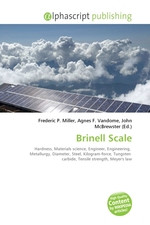Brinell Scale
Frederic P. Miller, Agnes F. Vandome, John McBrewster
бумажная книга
The Brinell scale characterizes the indentation hardness of materials through the scale of penetration of an indenter, loaded on a material test-piece. It is one of several definitions of hardness in materials science. Proposed by Swedish engineer Johan August Brinell in 1900, it was the first widely used and standardised hardness test in engineering and metallurgy. The large size of indentation and possible damage to test-piece limits its usefulness. The typical test uses a 10 mm diameter steel ball as an indenter with a 3,000 kgf (29 kN) force. For softer materials, a smaller force is used; for harder materials, a tungsten carbide ball is substituted for the steel ball. The BHN can be converted into the ultimate tensile strength (UTS), although the relationship is dependent on the material, and therefore determined empirically. The relationship is based on Meyer's index (n) from Meyer's law. If Meyer's index is less than 2.2 then the ratio of UTS to BHN is 0.36. If Meyer's index is greater then the ratio increases.
Данное издание не является оригинальным. Книга печатается по технологии принт-он-деманд после получения заказа.


